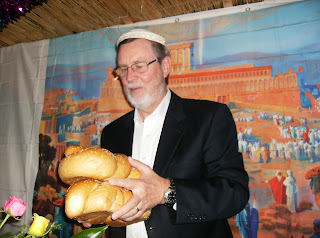John Enarson teaching the men how to wave the lulav.
Our beautiful sukkah after we decorated it.
The sukkah is in the courtyard of the AMI Center in the heart of Jerusalem.
Three new friends, Kathy Markward of Tennessee, a lady from Texas, and Joke de Vos from Holland.Nancy and Doris sat at the head table with Lars & Harriet Enarson and Henry from Canada.
Lars offering thanks for the bread.
Lars and Harriet Enarson, our hosts.
Doris Murdoch and Nancy.
The Feast of Tabernacles (Sukkot) is the final feast of the seven annual "feasts of the Lord" (Lev. 23:34-43), and its fulfillment will be in the reign of King Jesus on the earth. It lasts for seven days, and it is to commemorate God's provision and protection in the wilderness wanderings of the Israelites on their way to the Promised Land. The Israelites were commanded to build sukkot (booths or tabernacles). The event I attended was unique in that our group had our own sukkah. We decorated it, and we had meals and celebrated in it. Another biblical aspect of our enactment of the feast, besides dwelling in the sukkah, was the waving of the lulav, which consists of the etrog (fragrant lemon-like fruit of the beautiful tree), and branches of the palm, myrtle and willow trees (Lev. 23:40). John Enarson taught the men the proper way of waving the lulav, which he said was like a rehearsal for welcoming the Lord on His arrival in Jerusalem! At His first coming palm branches were waved before Jesus as He rode into Jerusalem on a donkey (Matt. 21:7-9).
John saw "a great multitude which no one could number, of all nations, tribes, peoples, and tongues, standing before the throne and before the Lamb, clothed with white robes, with palm branches in their hands" (Rev. 7:9). Did you know that all nations will celebrate the Feast of Tabernacles every year when Jesus is on His throne in the New Jerusalem? Here is what the prophet Zechariah declared: "And it shall come to pass that everyone who is left of all the nations [after Armageddon] which came against Jerusalem shall go up from year to year to worship the King, the Lord of hosts, and to keep the Feast of Tabernacles" (Zech. 14:16). So we were rehearsing!
Did you know that the Pilgrims likely fashioned their first Thanksgiving on the model of the biblical Feast of Tabernacles? They saw themselves as new Israelites in a new promised land. I found a wonderful article about this, Here is an excerpt:
In Jewish tradition, the Festival of Sukkot is a joyous occasion to give thanks and praise to the Source of Creation for the bounty we enjoy. In fact, we are told that during Sukkot, "you shall have nothing but joy." [Deut. 16:15] Jews erect a sukkah, a harvest booth, in which they eat their meals, and sometimes sleep, during the festival. It is a reminder of the booths in which their ancestors are said to have dwelled during their forty-year Sinai sojourn. It is also precisely the kind of structure farmers in the Middle East still construct at the edges of their fields as crops come ripe and the need to rise early for harvesting makes it prudent to sleep nearby.... The sukkah is a temporary structure, hung with fruits and symbols of the harvest season. Its roof is thinly covered with branches, admitting sunlight, starlight, wind, and rain, reminding of us the precariousness of our existence in the face of the forces of nature. ... There is a strong thread which runs from the Israelite wilderness experience to that of the Pilgrims and the harsh years they endured as they strove to sink roots in this new land. Like the ancient Israelites of whom they read in the Bible, they were people of great faith who believed themselves to be sustained through God's great mercy and beneficence.
That they should rejoice and give thanks at harvest time was as natural an impulse for the Pilgrims as it was for the ancient Israelites. By Rabbi Elias Lieberman








No comments:
Post a Comment